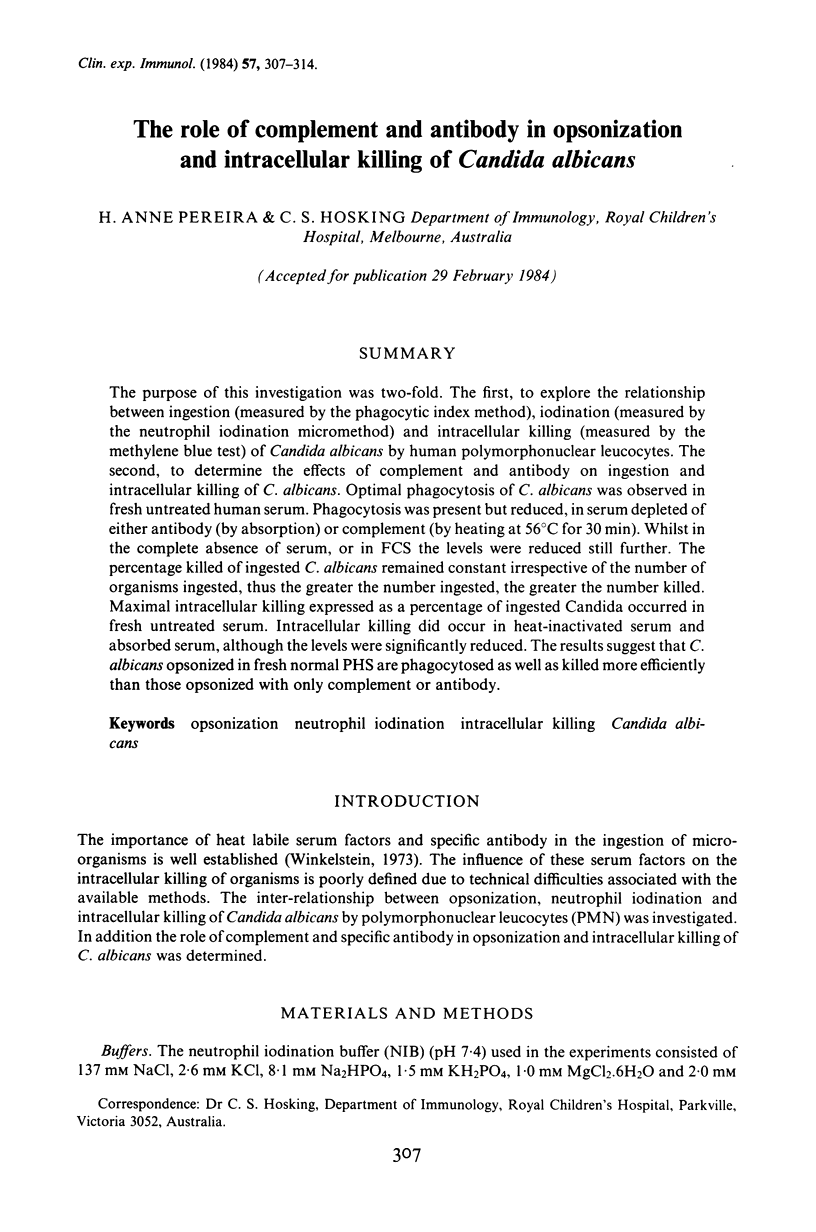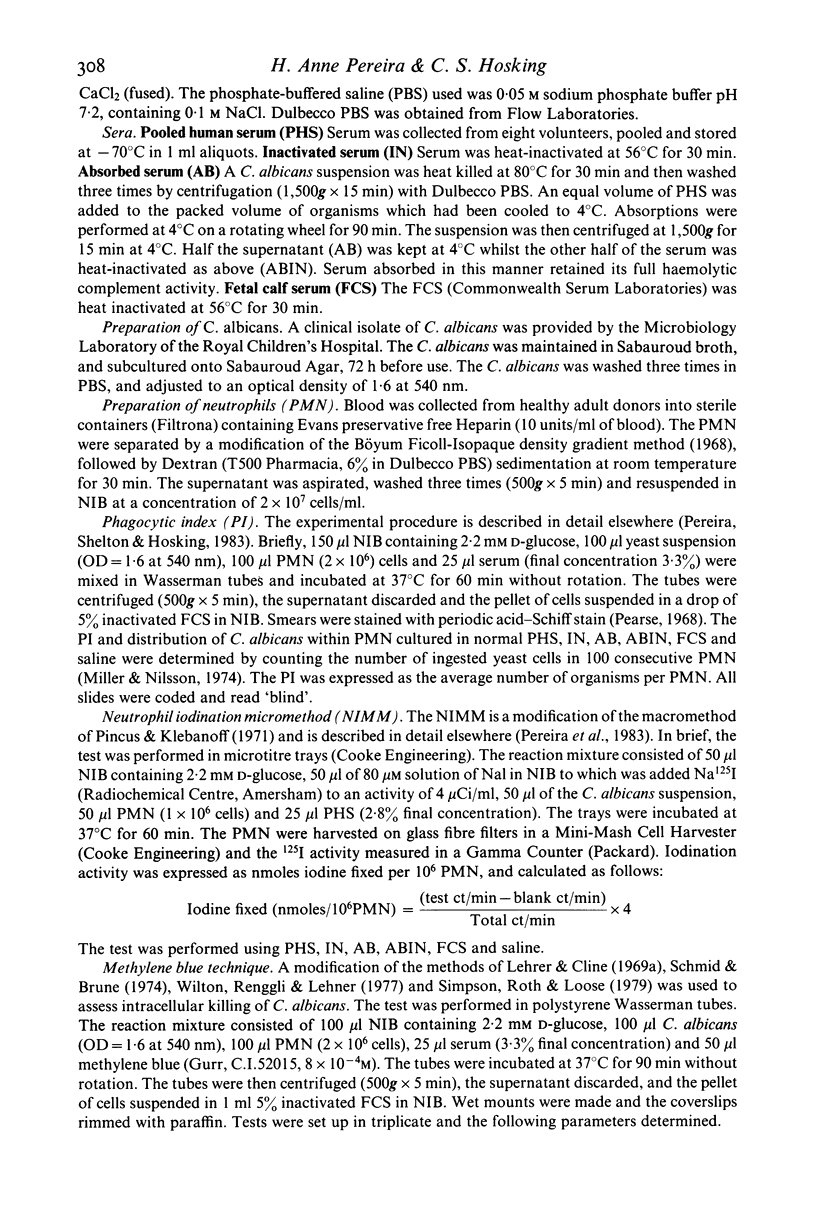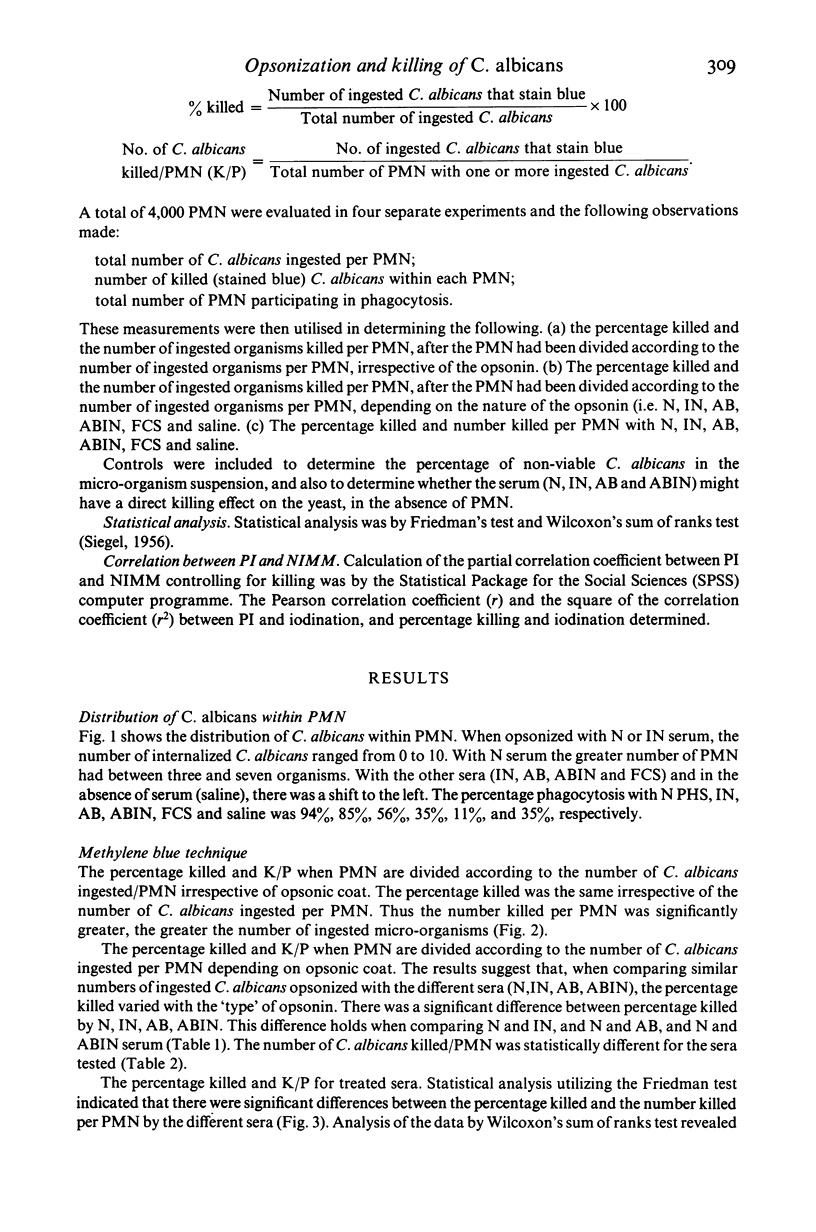Abstract
The purpose of this investigation was two-fold. The first, to explore the relationship between ingestion (measured by the phagocytic index method), iodination (measured by the neutrophil iodination micromethod) and intracellular killing (measured by the methylene blue test) of Candida albicans by human polymorphonuclear leucocytes. The second, to determine the effects of complement and antibody on ingestion and intracellular killing of C. albicans. Optimal phagocytosis of C. albicans was observed in fresh untreated human serum. Phagocytosis was present but reduced, in serum depleted of either antibody (by absorption) or complement (by heating at 56 degrees C for 30 min). Whilst in the complete absence of serum, or in FCS the levels were reduced still further. The percentage killed of ingested C. albicans remained constant irrespective of the number of organisms ingested, thus the greater the number ingested, the greater the number killed. Maximal intracellular killing expressed as a percentage of ingested Candida occurred in fresh untreated serum. Intracellular killing did occur in heat-inactivated serum and absorbed serum, although the levels were significantly reduced. The results suggest that C. albicans opsonized in fresh normal PHS are phagocytosed as well as killed more efficiently than those opsonized with only complement or antibody.
Full text
PDF







Selected References
These references are in PubMed. This may not be the complete list of references from this article.
- Davies R. R., Denning T. J. Candida albicans and the fungicidal activity of the blood. Sabouraudia. 1972 Nov;10(3):301–312. [PubMed] [Google Scholar]
- Ferrante A., Thong Y. H. Requirement of heat-labile opsonins for maximal phagocytosis of Candida albicans. Sabouraudia. 1979 Sep;17(3):293–297. doi: 10.1080/00362177985380431. [DOI] [PubMed] [Google Scholar]
- Lehrer R. I., Cline M. J. Interaction of Candida albicans with human leukocytes and serum. J Bacteriol. 1969 Jun;98(3):996–1004. doi: 10.1128/jb.98.3.996-1004.1969. [DOI] [PMC free article] [PubMed] [Google Scholar]
- Lehrer R. I., Cline M. J. Leukocyte myeloperoxidase deficiency and disseminated candidiasis: the role of myeloperoxidase in resistance to Candida infection. J Clin Invest. 1969 Aug;48(8):1478–1488. doi: 10.1172/JCI106114. [DOI] [PMC free article] [PubMed] [Google Scholar]
- Leijh P. C., van den Barselaar M. T., Daha M. R., van Furth R. Participation of immunoglobulins and complement components in the intracellular killing of Staphylococcus aureus and Escherichia coli by human granulocytes. Infect Immun. 1981 Sep;33(3):714–724. doi: 10.1128/iai.33.3.714-724.1981. [DOI] [PMC free article] [PubMed] [Google Scholar]
- Leijh P. C., van den Barselaar M. T., van Furth R. Kinetics of phagocytosis and intracellular killing of Candida albicans by human granulocytes and monocytes. Infect Immun. 1977 Aug;17(2):313–318. doi: 10.1128/iai.17.2.313-318.1977. [DOI] [PMC free article] [PubMed] [Google Scholar]
- Miller M. E., Nilsson U. R. A familial deficiency of the phagocytosis-enhancing activity of serum related to a dysfunction of the fifth component of complement (C5). N Engl J Med. 1970 Feb 12;282(7):354–358. doi: 10.1056/NEJM197002122820702. [DOI] [PubMed] [Google Scholar]
- Pereira H. A., Shelton M. J., Hosking C. S. Neutrophil iodination micro-method as an index of neutrophil and opsonic function. J Clin Lab Immunol. 1983 May;11(1):47–53. [PubMed] [Google Scholar]
- Pincus S. H., Klebanoff S. J. Quantitative leukocyte iodination. N Engl J Med. 1971 Apr 8;284(14):744–750. doi: 10.1056/NEJM197104082841402. [DOI] [PubMed] [Google Scholar]
- Schmid L., Brune K. Assessment of phagocytic and antimicrobial activity of human granulocytes. Infect Immun. 1974 Nov;10(5):1120–1126. doi: 10.1128/iai.10.5.1120-1126.1974. [DOI] [PMC free article] [PubMed] [Google Scholar]
- Schuit K. E. Phagocytosis and intracellular killing of pathogenic yeasts by human monocytes and neutrophils. Infect Immun. 1979 Jun;24(3):932–938. doi: 10.1128/iai.24.3.932-938.1979. [DOI] [PMC free article] [PubMed] [Google Scholar]
- Simpson D. W., Roth R., Loose L. D. A rapid, inexpensive and easily quantified assay for phagocytosis and microbicidal activity of macrophages and neutrophils. J Immunol Methods. 1979;29(3):221–226. doi: 10.1016/0022-1759(79)90309-0. [DOI] [PubMed] [Google Scholar]
- Solberg C. O., Christie K. E., Larsen B., Tonder O. Influence of antibodies and thermolabile serum factors on the bactericidal activity of human neutrophil granulocytes. Acta Pathol Microbiol Scand C. 1976 Apr;84(2):112–118. doi: 10.1111/j.1699-0463.1976.tb00007.x. [DOI] [PubMed] [Google Scholar]
- Solomkin J. S., Mills E. L., Giebink G. S., Nelson R. D., Simmons R. L., Quie P. G. Phagocytosis of Candida albicans by human leukocytes: opsonic requirements. J Infect Dis. 1978 Jan;137(1):30–37. doi: 10.1093/infdis/137.1.30. [DOI] [PubMed] [Google Scholar]
- Wilton J. M., Renggli H. H., Lehner T. A functional comparison of blood and gingival inflammatory polymorphonuclear leucocytes in man. Clin Exp Immunol. 1977 Jan;27(1):152–158. [PMC free article] [PubMed] [Google Scholar]
- Winkelstein J. A. Opsonins: their function, identity, and clinical significance. J Pediatr. 1973 May;82(5):747–753. doi: 10.1016/s0022-3476(73)80062-9. [DOI] [PubMed] [Google Scholar]
- Wood S. M., White A. G. A micro method for the estimation of killing and phagocytosis of Candida albicans by human leucocytes. J Immunol Methods. 1978;20:43–52. doi: 10.1016/0022-1759(78)90243-0. [DOI] [PubMed] [Google Scholar]
- Yamamura M., Boler J., Valdimarsson H. Phagocytosis measured as inhibition of uridine uptake by Candida albicans. J Immunol Methods. 1977;14(1):19–24. doi: 10.1016/s0022-1759(97)90016-8. [DOI] [PubMed] [Google Scholar]


